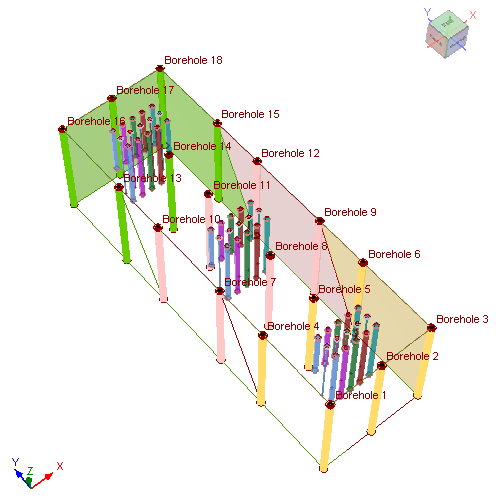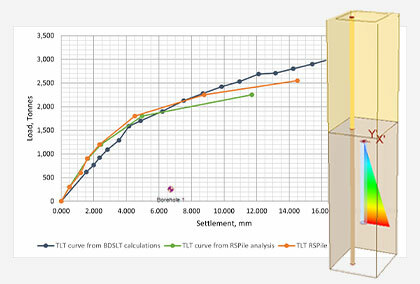RSPile: Effects of pile rigidity and soil stiffness on the settlement of piles
By Ahmed Mufty, Ph.D., P.Eng.
One of the benefits of having RSPile is the ability to do side research to have a better expectation of how piles will behave. In this article, RSPile showcases how to optimize the stiffness of the pile to consume more of the skin resistance capacity and get shorter flexible piles rather than having long stiff piles. This may lead to a more cost-effective analysis, especially if the settlement is within acceptable limits.
Practical application
Different piles of two diameters, 0.9m and 0.3m, having the same length of 15m are analyzed in addition to a series of piles of 0.9m diameter but with a shorter length of 10m. Piles have different modulus of elasticity varying from very stiff (rigid piles) of 2E+6 MPa to only 200 MPa. The piles analyzed are embedded in three different soil layers with variations in stiffness, having skin resistances of 60 kPa, 90 kPa, and 120 kPa respectively. The user-defined relative T-z curves are kept the same for the three soils to know exactly how the stiffness of the soil varies among the three cases.
The results from RSPile are discussed and presented to show how the piles are expected to behave under different stiffness conditions.
It is found that the stiffer the pile and the weaker the soil, the skin friction tends to be uniform along the depth with a smaller percentage of its ultimate capacity consumed. As the soil gets stiffer or the pile gets more flexible, the mobilized skin resistance approaches the ultimate values at the top parts of the pile and attenuates rapidly with depth leaving a long part of the pile useless. An introduction of the idea of effective length is then clearly noticed.
The soils used in the analysis are Soil 1, Soil 2, and Soil 3. To study the effect of soil stiffness and pile stiffness, distinguishing the soil stiffness should not be dependent on pile size or length. That is why it is better to choose the user-defined T-z curves instead of the other models in RSPile that are built-in. The user-defined T-z curves define the soil skin friction mobilization level based on the “absolute displacement” of the soil instead of relative displacements. In this approach, we can get different stiffness for the soil depending only on its ultimate skin resistance with reference to the same displacement value.
All three soils were set to have no tip resistance (end bearing capacity = 0). This will help to distribute the skin friction properly without the interference of the base to the load distribution. As mentioned in the introduction, the soils are given ultimate skin resistances of 60 kPa, 90 kPa, and 120 kPa, respectively.
Distribution of boreholes to create soil zones
Usually, the software would need to be run three times when changing the soil type. Instead, a simple trick is followed here to define three zones of soils that are different from each other in one model. This is done using 18 boreholes to define the main zones where the piles are installed and the transition zones where no piles will be installed.
The 18 boreholes are used to define the required soil zones to run the program one time for all cases. Boreholes 1 to 6 contain the zone of Soil 1, 7 to 12 for Soil 2, and 13 to 18 for Soil 3, while the intermediate zones are transition zones.
The piles are distributed in diameters, lengths and loads to adequately study the stiffness effects on the settlement. Forty-five piles are used with two diameters, 0.9m and 0.3m. The axial (vertical) load given to the 0.9m diameter piles is 300kN. To keep the same effect of length and perimeter on skin friction, a load of 100kN is applied at pile heads of the 0.3m diameter piles. Hence, the effect of rigidity can be studied easily. Piles are divided into five levels of Young’s modulus 2E10, 2E8, 2E6, 2E4, and 200kPa from very stiff piles (almost fully rigid compared to the soils) to extremely flexible. Two rows of piles installed in each soil are given 15m lengths. The third rows have shorter lengths of 10m.
The piles are spaced at 2m for convenience. There is no interaction between them.

The effects of the following parameters on settlement and skin friction distribution are studied and discussed in the article*:
- Effect of Pile Stiffness
- Effect of Pile Diameter
- Effect of Pile length
- Effect of Soil Stiffness
Conclusions:
- A tricky way to represent zones of different soils in one RSPile model is presented. Piles of different rigidity, diameter, and lengths have been studied to show how the rigidity of a pile may affect the settlement and skin friction distribution in soils of different stiffness.
- The article showed how rigid piles distribute the skin resistance uniformly along the pile depth.
- The idea of the effective length was presented at which the mobilized skin friction attenuates practically to nil. The more flexible the pile, the shorter the effective length.
- The skin friction and settlement of relatively flexible piles may not be affected significantly by the length of the piles provided that the piles are longer than the effective length.
- The use of absolute displacement T-z curves may cause confusion in the values of settlement for equal load/diameter ratio. The reason is that the elastic shortening depends on the area and not the diameter. It is possible that some soil-pile interactions may follow normalized displacement z/D instead of z only.
- As expected, it is found that the stiffer the soil, the more skin friction accumulates at the top-yielding shorter effective length and less settlement.
This practical application is the first in a series of cases that will be issued regularly in RocNews.
Read More
*The above article was an excerpt from the paper, “Effects of rigidity and soil stiffness on the settlement of piles (Using RSPile for understanding pile behavior),” by Ahmed Mufty, P.Eng., Ph.D. To read the full paper, click here.

